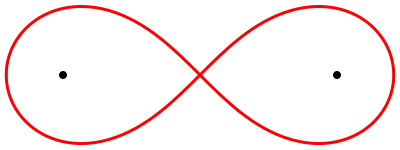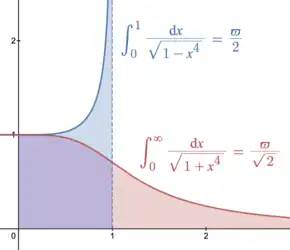Lemniscate constant
In mathematics, the lemniscate constant ϖ[1][2][3][4][5] is a transcendental mathematical constant that is the ratio of the perimeter of Bernoulli's lemniscate to its diameter, analogous to the definition of π for the circle. Equivalently, the perimeter of the lemniscate is 2ϖ. The lemniscate constant is closely related to the lemniscate elliptic functions and approximately equal to 2.62205755.[6][7][8][9] The symbol ϖ is a cursive variant of π; see Pi § Variant pi.

Gauss's constant, denoted by G, is equal to ϖ /π ≈ 0.8346268.[10]
John Todd named two more lemniscate constants, the first lemniscate constant A = ϖ/2 ≈ 1.3110287771 and the second lemniscate constant B = π/(2ϖ) ≈ 0.5990701173.[11][12][13][14]
Sometimes the quantities 2ϖ or A are referred to as the lemniscate constant.[15][16]
History
Gauss's constant is named after Carl Friedrich Gauss, who calculated it via the arithmetic–geometric mean as .[6] By 1799, Gauss had two proofs of the theorem that where is the lemniscate constant.[2][lower-alpha 1]
The lemniscate constant and first lemniscate constant were proven transcendental by Theodor Schneider in 1937 and the second lemniscate constant and Gauss's constant were proven transcendental by Theodor Schneider in 1941.[11][17][lower-alpha 2] In 1975, Gregory Chudnovsky proved that the set is algebraically independent over , which implies that and are algebraically independent as well.[18][19] But the set (where the prime denotes the derivative with respect to the second variable) is not algebraically independent over . In fact,[20]
Forms
Usually, is defined by the first equality below.[2][21][22]
where K is the complete elliptic integral of the first kind with modulus k, Β is the beta function, Γ is the gamma function and ζ is the Riemann zeta function.
The lemniscate constant can also be computed by the arithmetic–geometric mean ,
Moreover,
which is analogous to
where is the Dirichlet beta function and is the Riemann zeta function.[23]
Gauss's constant is typically defined as the reciprocal of the arithmetic–geometric mean of 1 and the square root of 2, after his calculation of published in 1800:[24]
Gauss's constant is equal to
where Β denotes the beta function. A formula for G in terms of Jacobi theta functions is given by
Gauss's constant may be computed from the gamma function at argument 1/4:
John Todd's lemniscate constants may be given in terms of the beta function B:
Series
Viète's formula for π can be written:
An analogous formula for ϖ is:[25]
The Wallis product for π is:
An analogous formula for ϖ is:[26]
A related result for Gauss's constant () is:[27]
An infinite series of Gauss's constant discovered by Gauss is:[28]
The Machin formula for π is and several similar formulas for π can be developed using trigonometric angle sum identities, e.g. Euler's formula . Analogous formulas can be developed for ϖ, including the following found by Gauss: , where is the lemniscate arcsine.[29]
The lemniscate constant can be rapidly computed by the series[30][31]
where (these are the generalized pentagonal numbers).
In a spirit similar to that of the Basel problem,
where are the Gaussian integers and is the Eisenstein series of weight (see Lemniscate elliptic functions § Hurwitz numbers for a more general result).[32]
A related result is
where is the sum of positive divisors function.[33]
In 1842, Malmsten found
where is Euler's constant.
Gauss's constant is given by the rapidly converging series
The constant is also given by the infinite product
Continued fractions
A (generalized) continued fraction for π is
An analogous formula for ϖ is[12]
Define Brouncker's continued fraction by[34]
Let except for the first equality where . Then[35][36]
For example,
Integrals

ϖ is related to the area under the curve . Defining , twice the area in the positive quadrant under the curve is In the quartic case,
In 1842, Malmsten discovered that[39]
Furthermore,
and[40]
a form of Gaussian integral.
Gauss's constant appears in the evaluation of the integrals
The first and second lemniscate constants are defined by integrals:[11]
Circumference of an ellipse
Gauss's constant satisfies the equation[41]
Euler discovered in 1738 that for the rectangular elastica (first and second lemniscate constants)[42][41]
Now considering the circumference of the ellipse with axes and , satisfying , Stirling noted that[43]
Hence the full circumference is
This is also the arc length of the sine curve on half a period:[44]
Notes
- although neither of these proofs was rigorous from the modern point of view.
- In particular, he proved that the beta function is transcendental for all such that . The fact that is transcendental follows from and similarly for B and G from
References
- Gauss, C. F. (1866). Werke (Band III) (in Latin and German). Herausgegeben der Königlichen Gesellschaft der Wissenschaften zu Göttingen. p. 404
- Cox 1984, p. 281.
- Eymard, Pierre; Lafon, Jean-Pierre (2004). The Number Pi. American Mathematical Society. ISBN 0-8218-3246-8. p. 199
- Bottazzini, Umberto; Gray, Jeremy (2013). Hidden Harmony – Geometric Fantasies: The Rise of Complex Function Theory. Springer. doi:10.1007/978-1-4614-5725-1. ISBN 978-1-4614-5724-4. p. 57
- Arakawa, Tsuneo; Ibukiyama, Tomoyoshi; Kaneko, Masanobu (2014). Bernoulli Numbers and Zeta Functions. Springer. ISBN 978-4-431-54918-5. p. 203
- Finch, Steven R. (18 August 2003). Mathematical Constants. Cambridge University Press. p. 420. ISBN 978-0-521-81805-6.
- Kobayashi, Hiroyuki; Takeuchi, Shingo (2019), "Applications of generalized trigonometric functions with two parameters", Communications on Pure & Applied Analysis, 18 (3): 1509–1521, arXiv:1903.07407, doi:10.3934/cpaa.2019072, S2CID 102487670
- Asai, Tetsuya (2007), Elliptic Gauss Sums and Hecke L-values at s=1, arXiv:0707.3711
- "A062539 - Oeis".
- "A014549 - Oeis".
- Todd, John (January 1975). "The lemniscate constants". Communications of the ACM. 18 (1): 14–19. doi:10.1145/360569.360580. S2CID 85873.
- "A085565 - Oeis".
- "A076390 - Oeis".
- Carlson, B. C. (2010), "Elliptic Integrals", in Olver, Frank W. J.; Lozier, Daniel M.; Boisvert, Ronald F.; Clark, Charles W. (eds.), NIST Handbook of Mathematical Functions, Cambridge University Press, ISBN 978-0-521-19225-5, MR 2723248.
- "A064853 - Oeis".
- "Lemniscate Constant".
- Schneider, Theodor (1941). "Zur Theorie der Abelschen Funktionen und Integrale". Journal für die reine und angewandte Mathematik. 183 (19): 110–128. doi:10.1515/crll.1941.183.110. S2CID 118624331.
- G. V. Choodnovsky: Algebraic independence of constants connected with the functions of analysis, Notices of the AMS 22, 1975, p. A-486
- G. V. Chudnovsky: Contributions to The Theory of Transcendental Numbers, American Mathematical Society, 1984, p. 6
- Borwein, Jonathan M.; Borwein, Peter B. (1987). Pi and the AGM: A Study in Analytic Number Theory and Computational Complexity (First ed.). Wiley-Interscience. ISBN 0-471-83138-7. p. 45
- Finch, Steven R. (18 August 2003). Mathematical Constants. Cambridge University Press. pp. 420–422. ISBN 978-0-521-81805-6.
- Schappacher, Norbert (1997). "Some milestones of lemniscatomy" (PDF). In Sertöz, S. (ed.). Algebraic Geometry (Proceedings of Bilkent Summer School, August 7–19, 1995, Ankara, Turkey). Marcel Dekker. pp. 257–290.
- "A113847 - Oeis".
- Cox 1984, p. 277.
- Levin (2006)
- Hyde (2014) proves the validity of a more general Wallis-like formula for clover curves; here the special case of the lemniscate is slightly transformed, for clarity.
- Hyde, Trevor (2014). "A Wallis product on clovers" (PDF). The American Mathematical Monthly. 121 (3): 237–243. doi:10.4169/amer.math.monthly.121.03.237. S2CID 34819500.
- Bottazzini, Umberto; Gray, Jeremy (2013). Hidden Harmony – Geometric Fantasies: The Rise of Complex Function Theory. Springer. doi:10.1007/978-1-4614-5725-1. ISBN 978-1-4614-5724-4. p. 60
- Todd (1975)
- Cox 1984, p. 307, eq. 2.21 for the first equality. The second equality can be proved by using the pentagonal number theorem.
- Berndt, Bruce C. (1998). Ramanujan's Notebooks Part V. Springer. ISBN 978-1-4612-7221-2. p. 326
- Eymard, Pierre; Lafon, Jean-Pierre (2004). The Number Pi. American Mathematical Society. ISBN 0-8218-3246-8. p. 232
- Garrett, Paul. "Level-one elliptic modular forms" (PDF). University of Minnesota. p. 11—13
- Khrushchev, Sergey (2008). Orthogonal Polynomials and Continued Fractions (First ed.). Cambridge University Press. ISBN 978-0-521-85419-1. p. 140 (eq. 3.34), p. 153. There's an error on p. 153: should be .
- Khrushchev, Sergey (2008). Orthogonal Polynomials and Continued Fractions (First ed.). Cambridge University Press. ISBN 978-0-521-85419-1. p. 146, 155
- Perron, Oskar (1957). Die Lehre von den Kettenbrüchen: Band II (in German) (Third ed.). B. G. Teubner. p. 36, eq. 24
- "A062540 - OEIS". oeis.org. Retrieved 2022-09-14.
- "A053002 - OEIS". oeis.org.
- Blagouchine, Iaroslav V. (2014). "Rediscovery of Malmsten's integrals, their evaluation by contour integration methods and some related results". The Ramanujan Journal. 35 (1): 21–110. doi:10.1007/s11139-013-9528-5. S2CID 120943474.
- "A068467 - Oeis".
- Cox 1984, p. 313.
- Levien (2008)
- Cox 1984, p. 312.
- Adlaj, Semjon (2012). "An Eloquent Formula for the Perimeter of an Ellipse" (PDF). American Mathematical Society. p. 1097.
One might also observe that the length of the "sine" curve over half a period, that is, the length of the graph of the function sin(t) from the point where t = 0 to the point where t = π , is .
In this paper and .
- Weisstein, Eric W. "Gauss's Constant". MathWorld.
- Sequences A014549, A053002, and A062539 in OEIS
- Cox, David A. (January 1984). "The Arithmetic-Geometric Mean of Gauss" (PDF). L'Enseignement Mathématique. 30 (2): 275–330. doi:10.5169/seals-53831. Retrieved 25 June 2022.
External links
- "Gauss's constant and where it occurs". www.johndcook.com. 2021-10-17.
